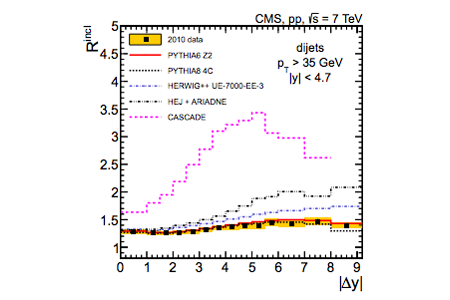
A study of dijet production in proton-proton collisions was performed at √s = 7 TeV for jets with pT > 35 GeV and |y| < 4.7[1] using data collected with the CMS detector at the LHC in 2010. Events with at least one pair of jets are denoted as “inclusive”, while events with exactly one pair of jets are called “exclusive”. The ratio of the production rate (cross-section) of all paired combinations of jets to the exclusive dijet production rate as a function of the rapidity difference between jets |Δy| is measured for the first time up to |Δy| = 9.2. The ratio of the production rate for the pair consisting of the most forward and the most backward jet from the inclusive sample to the exclusive dijet production rate is also presented. The predictions of the Monte Carlo event generators PYTHIA6 and PYTHIA8 agree with the measurements. In both ratios, the HERWIG++ generator exhibits a more pronounced rise versus |Δy| than observed in the data. The CASCADE and HEJ+ARIADNE generators predict a significantly stronger rise than observed for these ratios.
[1] y is the rapidity, defined as (1/2)log[(E + pz)/(E − pz)], where E = the energy (of the jets, in this case) and pz = the momentum in the Z direction
- Log in to post comments

